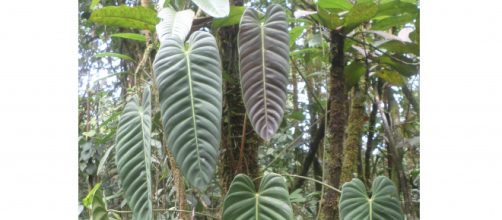Araceae are often referred to as aroids. This is an incredibly diverse and widely spread family of plants. Aroids are found on every continent in the world except the Arctic Circle & Antarctica. There are Araceae in the deserts and the wetlands of the Americas, Asia, and Africa. Those from Colombia are called Neotropical Aroids which is to say they found within the New World.
Inflorescence
Araceae are a family of plants identified by the structure of their flower-bearing organ called an inflorescence. This is a two-part appendage that has spathe and spadix.
The spathe is a modified leaf that protects the spadix. The spadix carries the flowers of the plant. This organ exudes pheromones to attract pollinators during anthesis.
Anthesis
Anthesis is the fertility phase of the flowering structure which consists of 1 night to 2 or 3 weeks of female fertility followed by an equal male fertility stage when the male flowers produce pollen. During female anthesis, the spathe and spadix may warm while the spathe exudes the pheromone scent which attracts pollinators. These are insects, usually beetles or flies who come to the inflorescence to feed on pollen and sterile flowers. They also mate during this time. When the male stage starts pollen is dropped on the insects which are then expelled from the inflorescence through varied methods.
The inflorescence may produce a repellent or simply close the spathe. They then carry pollen on to the next female inflorescence in anthesis.
Ecological importance
These plants are often seen as pest, parasites, or worse. This could not be farther from the truth. These plants help to protect the fertility of the forest. Rainforests tend to have one problem. The constant rains strip nutrients from the topsoil of the forest leaving all plants with a serious predicament in how to obtain precious nutrients to survive. These plants are integral in this area. Monsteras, Philodendrons, and Syngonium are a very common Araceae in Colombia with very interesting traits to help with nutrient gathering.
They all attach to the surface of trees and climb up to the top of the canopy where they can easily gather light and rain.
What is interesting about this is the shape of their leaves and the petioles attaching the leaves to the stems of the plants allows them to direct dust filled rainwater down their stems. This mutual benefit is shared with its host tree. Why is this important? This directs water filled with minerals and nutrients gathered from dust blown across the oceans to Colombia allowing the tree to be fed.
Decomposition and nutrient availability
When these same plants drop leaves or other parts such as flowering structures they also decompose adding nutrient-rich hummus to the topsoil of the forest. This hummus is utilized by every forest plant and is an integral part of the forest ecosystem. Modern cultivation techniques such as alley cropping have been inspired by this mutualistic relationship between this family of plants and the forest.


